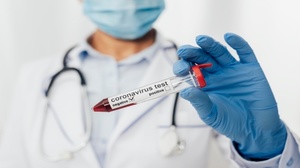The most widely used diagnostic test for Covid-19 across the globe has been the RT-PCR (Reverse Transcription- Polymerase Chain Reaction) test. Newer tests have been developed, including swab tests and nasal tests. Still, none has come to trump the reliability of the RT-PCR test. This test is also used for detecting Influenza A, Influenza B, and the H1N1 virus. Karry Mullis, an American biochemist, invented this test.
RT-PCR procedure works by detecting the presence of genetic material of the novel coronavirus or SARS-COV-2. First, a long nasal swab or a nasopharyngeal swab is inserted through the nostrils or the mouth, reaching to the back of the throat to collect the fluid sample. This virus is made up of RNA and thus needs to be converted into DNA to be detected. An enzyme called ‘Polymerase’ is used in ‘Reverse Transcription’ to convert the sample into DNA. ‘Chain Reaction’ is the method through which the DNA is copied exponentially to detect the virus. A DNA binding fluorescent dye called ‘probe’ shows if the virus is present.
Some Covid-19 RT-PCR test results give an accompanying parameter under the title of ‘cycle threshold’ or ‘CT’ value. Cycle threshold indicates the number of times the RNA material had to Qbe copied to detect the virus. AIf the virus is present in a small amount; the viral RNA has to be copied many times for detection. If the virus is of a more significant load, the cycle threshold reduces. Expert medical opinion is divided whether CT value is a reliable indicator of viral load or how infectious a patient can be. Although some say that conclusive links can be drawn between CT value and how severe the infection is, it hasn’t yet been adopted as a standard for predicting the transmission rate of the infection.
An RT-PCR test takes around 4.5 hours to 6 hours to generate results. However, the period from sample collection to delivery of the test result may well range from 12 to 24 hours.
Although this test has been the gold standard for virus detection since the start of the pandemic, there have been concerns about the test turning up false-negative results even when a person is infected with Covid-19. This could happen if the sample was not properly collected, if the virus is no longer present in the upper respiratory tract or if the patient gets the test done too late.
With a new and potentially more transmittable and lethal mutation of the SARS-COV-2, named ‘Omicron’ by the WHO, being detected, there have been concerns about whether this virus will not only escape vaccine-built immunity but also if it can always be detected through RT-PCR testing. Nonetheless, this test remains the most reliable one, given that this virus and its mutating characteristics point towards a much more drawn-out pandemic. WHO chief, Dr. Michael Ryan, who is leading the committee on Covid-19, commented back in May 2020 that this virus may never go away as it might become endemic to communities.

